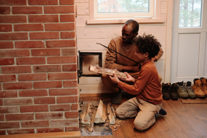Teeth are something that all of us should be familiar with, but something that we can take for granted by not giving them the care they need. On average, adult humans have anywhere from 28 to 32 teeth, depending on if you have your wisdom teeth. Below, we’ll go over the basic parts of a tooth. Perhaps if you know more about your teeth, you will be inclined to take better care of them. A lot of damage that happens to teeth is irreversible and can only be fixed with invasive procedures or surgery.
Take care of the ones you have and your next trip to the Manahawkin dentist will be a joy!
Crown – The crown of the tooth is what most people recognize as a tooth itself. It is the visible part of the tooth that is above the gum line and is used to bite and chew. When your dentist examines your teeth, they also look for wear on the crown of the teeth indicating either improper alignment or grinding or clenching of your teeth at night. They will discuss any problems and possible solutions because clenching and grinding of your teeth can lead to cracks, breakage, and wearing down of the teeth.
Enamel – The protective layer on the outside of teeth. If the enamel of your tooth starts to decay, this is when cavities form. Brushing your teeth at least twice daily for 2 minutes at a time and flossing daily helps to keep your enamel clean and free of excessive plaque and tartar. Without brushing, plaque and tartar can start to wear away your enamel, leaving your tooth vulnerable to cavities and discoloration. Once enamel is worn away, it does not grow back.

Dentin – The layer below the enamel. This layer is softer than enamel and has channels in it that run down to the pulp and is connected to nerves which can cause pain when your enamel is worn away. As discussed above, brushing and flossing are the most important things you can do to protect your teeth and mouth from decay.
Pulp – The center most portion of a tooth. Where all the nerves and blood vessels are found and if decay reaches this layer, you may have severe pain. The root canal runs from the root to the pulp which is why it is so painful if you have a cavity where these inner portions of the tooth is exposed.
Gum Line – Also known as gingiva, it is the fleshy area in your mouth where your gums and teeth meet. At your regular check-ups with your dentist, they will monitor any gum recession that will warn of gum disease and other problems.
Root – The part of the tooth that is below the gumline that provides stability and support to your teeth.
Hopefully knowing a little more about the anatomy of your teeth will help you understand how important dental hygiene is. Brushing and flossing are so simple and yet are not done properly or often enough by many. When it comes to your teeth, prevention is the best medicine. If you are having any pain or discomfort in your mouth, contact your trusted Manahawkin dentist right away.



